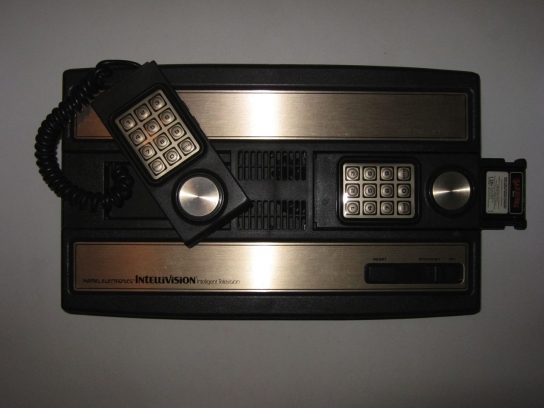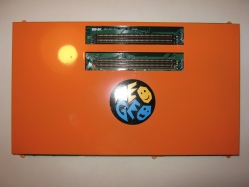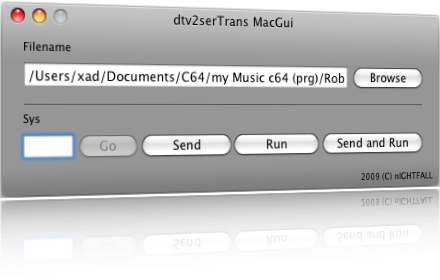 ACID 64 Player Pro is the sequal of Acid 64 Player and is a cycle based Commodore 64 music player designed for playing SID tunes on sound cards/devices that have a real SID chip (6581/6582/8580) on board like the HardSID cards and HardSID 4U USB device.
ACID 64 Player Pro is the sequal of Acid 64 Player and is a cycle based Commodore 64 music player designed for playing SID tunes on sound cards/devices that have a real SID chip (6581/6582/8580) on board like the HardSID cards and HardSID 4U USB device.
ACID 64 emulates the MOS 6510 micro processor, the 6526 CIA chip and partially the 6569 VIC chip to run the code of a SID tune and it controls the SID chip on the device for playing the Commodore 64 music.
What’s new in version 3.0.0
New:
- Fast incremental SID file search on title, author, year and publisher fields
- Seek through SID tunes via slider bar
- Digital clock
- Scroll wheel support when hovering over grids and list boxes
- Anonymous usage statistics
Improvements:
- Tree view of folders
- SidID search in properties menu is done in background now to access dialog faster
- Emulation improvements
- Keyboard navigation improvements
- Many small improvements/fixes
screenshot:
source: acid64.com

Autopsy:
from Wikipedia homepage:
 The Intellivision was developed by Mattel Electronics, a subsidiary of Mattel formed expressly for the development of electronic games.
The Intellivision was developed by Mattel Electronics, a subsidiary of Mattel formed expressly for the development of electronic games.
The console was test marketed in Fresno, California, in 1979 with a total of four games available, and was released nationwide in 1980 with a price tag of US$299 and a pack-in game: Las Vegas Poker & Blackjack. Though not the first system to challenge Atari, it was the first to pose a serious threat to Atari’s dominance.
A series of ads featuring George Plimpton was produced that mercilessly attacked the Atari 2600′s lesser capabilities with side-by-side game comparisons.
source: wikipedia

Autopsy:
from Wikipedia:
The Neo Geo is a cartridge-based arcade and home video game system released in 1990 by Japanese game company SNK. The system offered comparatively colorful 2D graphics and high-quality sound.
A major platform for arcade games at the time, the system was also available as a costly home console. The two versions of the system were known as the AES (Advanced Entertainment System, the home version) and the MVS (Multi Video System, the arcade version).
The Neo Geo was marketed as 24-bit, though it was technically an 8/16/32-bit multiprocessing system.
source: wikipedia
Unboxing:
from Universe Bios Homepage:
The UNIVERSE BIOS is for owners of MVS or AES hardware that want an easy way to change country region or between Arcade or Console mode on boot. Also included are other features that are not possible using the standard MVS bios.
The UNIVERSE BIOS is also designed to give easy access to things like inserting coins, test mode and memory card management when using the joystick ports only. Of course the BIOS still allows standard operation too.
source: unibios.free.fr
 C64 VGE is small graphics editor in which You can make little sized pictures beacause of using lines and small amount of pixels to draw them.
C64 VGE is small graphics editor in which You can make little sized pictures beacause of using lines and small amount of pixels to draw them.
It was used to made graphics for almost 4K intro “4K Wannabe” by Black Sun and now it’s released to public, maybe it’ll be usefull for someone other than me.
There are 3 example pictures from “4K Wannabe” supplied with editor for You to grasp the concept.
source: noname.c64.org
 This is a new demo for the VIC-20 released by Pasi Ojala. This demo runs on a un-expanded VIC-20 with a disk drive.
This is a new demo for the VIC-20 released by Pasi Ojala. This demo runs on a un-expanded VIC-20 with a disk drive.
The very cool music was made by Anders Carlsson.
source: www.cs.tut.fi/~albert/Pu-239/vicual-mmix
 From the Homepage.
From the Homepage.
ROM-el ROM Eliminator: Another project of mine requires a way to replace the 2364 ROMs on Commodore computers, so I started looking for a 2764 to 2364 adapter.
After designing one, I determined that DIP EPROMs are starting to get very expensive, so I set about designing a Flash version. My tentative name is ROM-el. Since Flash is considered ROM as well, the name is a bit off, but I liked it, and only the pedantic will probably care.
64Nic: 2 64NIC+ boards arrived on April 20, and I assembled one in the evening. Initial testing with Devia’s NIC-Test was unsuccessful, so I gave up for the night. After work on the 21st, I pored over the schematics and determined I had miscopied a resistor layout from Eric Pratt’s 64NIC design. The resistor must be tied to ground, not Vcc. Dubious that such a small change would make the board work, I nonetheless made the change and …. it did nothing.
I decided I’d ruined one board, so I assembled the second board, taking care to make the resistor mod before plugging it in. Devia’s NIC-Test worked immediately. Later, I tried the apparently ruined board and it also worked, so it appears I did not completely ruin the board.
Given the success, I immediately released the board to production that evening.
source: jbrain.com
 Java Ice Team Tracker 64 is a java based music tracker (editor) for creating music for SID chip of Commodore 64. Instruments are totally based onto tables for full control of sound generation.
Java Ice Team Tracker 64 is a java based music tracker (editor) for creating music for SID chip of Commodore 64. Instruments are totally based onto tables for full control of sound generation.
The new version comes with some bugs fixed and new features:
- Option: add the disable conditional compilation optimization.
- Option: you can select 4 type of frequencies table.
- Option: filter cut off frequency can now be in siddump format.
- Option: load/store position/size of pattern and instrument windows.
- Pattern: add an external separate windows.
- Pattern: paste can be indipendent for note/instrument/command.
- Pattern: notes in selection can be inc/dec for one octave or half step.
- Pattern: octave up/dn and instrument +/- can be activated by keyboard shortcut.
- Instrument: add missing notify background compilation for AD/SR/Wave changes.
- Instrument: fix bugged move of instrument in list.
- Packer: add missing write of ‘write order’
- Player: conditional compilation to remove instrument code not used.
- Player: can now use 4 tables of frequencies.
- Player: fix test of write order.
- Player: improve quality of sexy-hardrestart.
- Player: fix rel note in instrument that kill tone-portamento. Now you can skip hardrestart in tone-portamento by not use instrument in the line where you start portamento command.
- Song: add a progress indicator when loading/saving a song.
download: sourceforge.net
 After this update, the collection should contain 36,000 SID files!
After this update, the collection should contain 36,000 SID files!
This update features (all approximates):
- 678 new SIDs
- 59 fixed/better rips
- 573 PlaySID/Sidplay1 specific SIDs eliminated
- 189 repeats/bad rips eliminated
- 482 SID credit fixes
- 135 SID model/clock infos
- 15 tunes from /DEMOS/UNKNOWN/ identified
- 10 tunes from /GAMES/ identified
- 36 tunes moved out of /DEMOS/ to their composers’ directories
- 11 tunes moved out of /GAMES/ to their composers’ directories
source: hvsc.c64.org

DTV2Ser Trans MAC Gui v0.1 – Concept idea, UI design: Xad – Coding: Lynx This is a simple oSX GUI for dtv2sertrans from Lallafa,
it runs natively on both PPC and Intel based Macs (Universal Binary),requires Mac OS X 10.4 or later.
Features:
- Transfer C64 PRG.
- Send/Run/Send and Run.
- You can use the SYS for start your proggy.
- Debug Output Windows.
- Preferences for Enable/Disable Debug Windows and for configure the dtv2sertrans path.
- USB Hardware check.
- AutoUpdate.
Screenshot:
Download: Dtv2SerTransMacGUI (1812)
source: macupdate.com noname.c64.org versiontracker.com
 from Engadget: Look: there are purses, and then there are purses. Well, this one is none of those things. It’s a decent looking bag to begin with, but then… well, things get really fantastic.
from Engadget: Look: there are purses, and then there are purses. Well, this one is none of those things. It’s a decent looking bag to begin with, but then… well, things get really fantastic.
Jeri Ellsworth took it upon herself to cram a Nintendo-on-a-chip and a Commodore 64-on-a-chip (her own creation) into the bag, along with an LCD. Then she connected up some NES controllers, which are velcroed onto the outside of the bag. The result looks awesome, and is also actually useable.
We haven’t heard anything about these guys being offered for sale, but we’re fairly certain that the august House of Dior will probably be ringing her up any day now. Seriously: this thing is a work of art.
source: engadget.com
ULoad is a loader system I developed for my Ultima gold cracks. This is a cleaned up version of the loader I developed for Ultima 3 Gold, which is a relatively basic 2-bit timed IRQ file loader.
It also allows you to save files, although it’s limited to overwriting existing files and cannot create new files. It supports a wide range of IEC drives, of course works on both PAL and NTSC, and also supports SuperCPU and DTV2 running in turbo mode.
source: paradroid.net/uload
This is a old post on webdesignerdepot.com , but it’s always nice to read.
from WebDesignerDepot:
A Graphical User Interface (GUI for short) allows users to interact with the computer hardware in a user friendly way.
Over the years a range of GUI’s have been developed for different operating systems such as OS/2, Macintosh, Windowsamiga, Linux, Symbian OS, and more.
We’ll be taking a look at the evolution of the interface designs of the major operating systems since the 80’s.
I should mention that this article showcases only the significant advances in GUI design (not operating system advances) and also not all of the graphical user interfaces and operating systems existing today.
source: webdesignerdepot.com
 ACID 64 Player Pro is the sequal of Acid 64 Player and is a cycle based Commodore 64 music player designed for playing SID tunes on sound cards/devices that have a real SID chip (6581/6582/8580) on board like the HardSID cards and HardSID 4U USB device.
ACID 64 Player Pro is the sequal of Acid 64 Player and is a cycle based Commodore 64 music player designed for playing SID tunes on sound cards/devices that have a real SID chip (6581/6582/8580) on board like the HardSID cards and HardSID 4U USB device.























 The Intellivision was developed by Mattel Electronics, a subsidiary of Mattel formed expressly for the development of electronic games.
The Intellivision was developed by Mattel Electronics, a subsidiary of Mattel formed expressly for the development of electronic games.



















 C64 VGE is small graphics editor in which You can make little sized pictures beacause of using lines and small amount of pixels to draw them.
C64 VGE is small graphics editor in which You can make little sized pictures beacause of using lines and small amount of pixels to draw them.
 This is a new demo for the VIC-20 released by Pasi Ojala. This demo runs on a un-expanded VIC-20 with a disk drive.
This is a new demo for the VIC-20 released by Pasi Ojala. This demo runs on a un-expanded VIC-20 with a disk drive. From the Homepage.
From the Homepage. Java Ice Team Tracker 64 is a java based music tracker (editor) for creating music for SID chip of Commodore 64. Instruments are totally based onto tables for full control of sound generation.
Java Ice Team Tracker 64 is a java based music tracker (editor) for creating music for SID chip of Commodore 64. Instruments are totally based onto tables for full control of sound generation. After this update, the collection should contain 36,000 SID files!
After this update, the collection should contain 36,000 SID files!

 from Engadget: Look: there are purses, and then there are purses. Well, this one is none of those things. It’s a decent looking bag to begin with, but then… well, things get really fantastic.
from Engadget: Look: there are purses, and then there are purses. Well, this one is none of those things. It’s a decent looking bag to begin with, but then… well, things get really fantastic.


Recent Comments